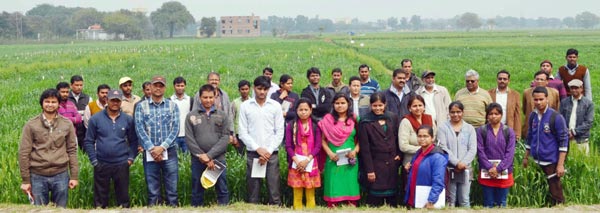By Arun Joshi/CIMMYT
CIMMYT-Nepal and Banaras Hindu University (BHU) organized a training program on spot blotch in wheat from 21-23 February for scientists, students and field workers.
The program was part of the Cereal Systems Initiative for South Asia (CSISA) project Objective 4 and the CGIAR Research Program Strategic Initiative 5. It was an extension of activities conducted in the last crop cycle by Ramesh Chand and V.K. Mishra, BHU and CIMMYT’s Arun Joshi. Of the 45 participants, 11 were female, 42 were from India, two came from Nepal and one was from Nigeria. Participants represented institutions including the Sam Higginbotom Institute of Agriculture, Technology and Sciences, Naini, Allahabad; Rajendra Agricultural University (RAU), Pusa Bihar; Bihar Agricultural University (BAU), Bhagalpur Bihar; Uttar Banga Krishi Vishwavidayalaya (UBKV), West Bengal; Indian Institute of Science Education and Research (IISER), Kolkata, West Bengal; and BHU.

Trainees visited the laboratory established by Arun Joshi and Vinod Mishra under the Indian Council of Agricultural Research “Niche Area of Excellence” for molecular research on spot blotch in wheat. The trainees practiced DNA extraction from wheat leaves, learned steps for the purification of DNA, examined spot blotch symptoms, practiced isolation techniques from the infected leaves and recorded variation in the pathogen colony.
They prepared slides from infected leaves and observed the typical conidia spores and conidiophores of the pathogen Bipolaris sorokiniana. Participants characterized symptoms on 484 wheat lines and noted the progress of spot blotch disease during a visit to the polyhouse. They also recorded data on a range of hosts for this pathogen, prepared inoculum and counted spores in the suspension to maintain uniform inoculum.
Trainees were taught to use photography and C3 software to count lesions. They were also taught histopathological skills to understand the behavior of resistant wheat genotypes. Finally, trainees visited CSISA wheat nurseries, identified initial spot blotch symptoms and learned to distinguish them from similar symptoms.
Each participant screened 50 lines for the lesion mimic and appearance of spot blotch, which was then verified by experts. An interactive session allowed participants to ask questions prior to a graduation ceremony conducted by V.K. Mishra and Pawan Singh
 Capacity development
Capacity development